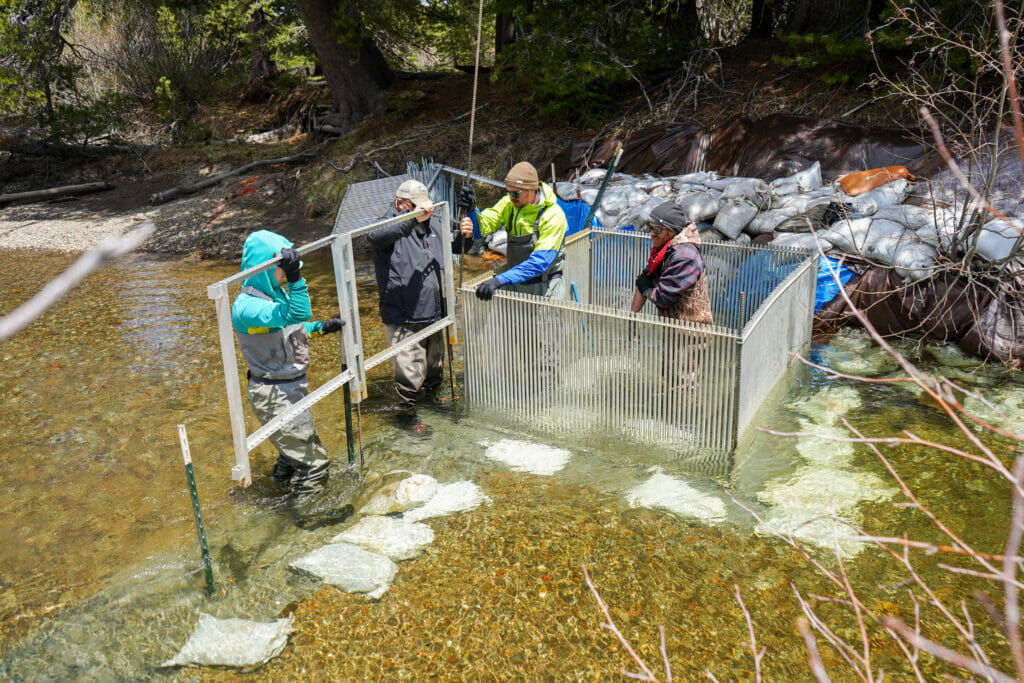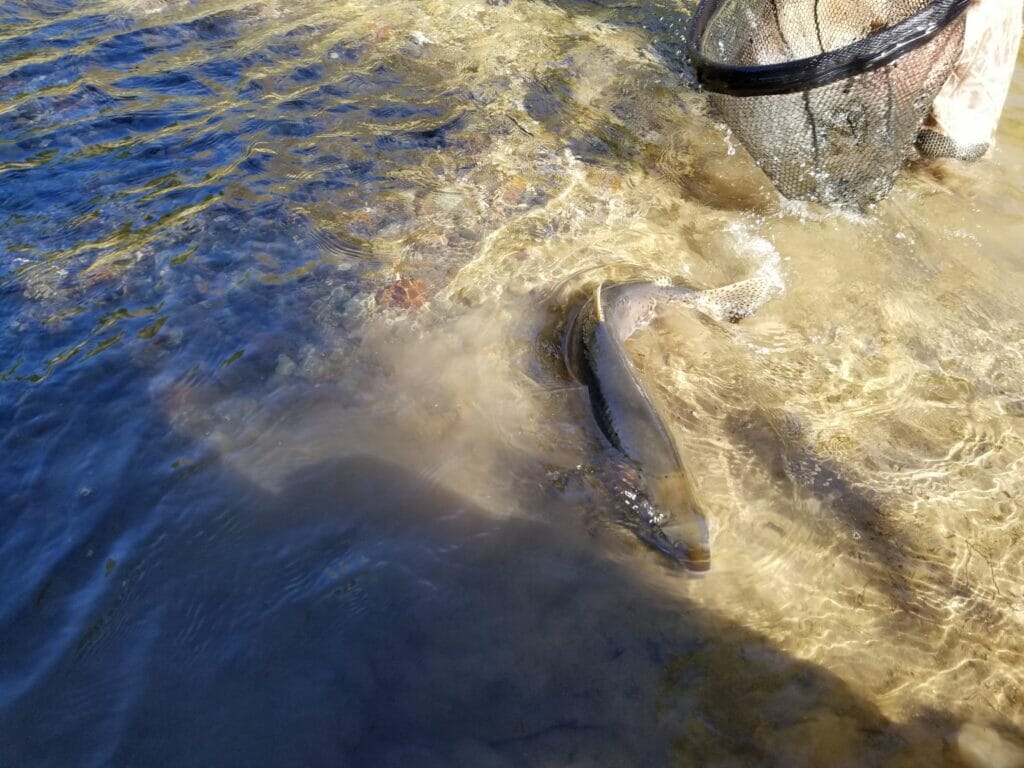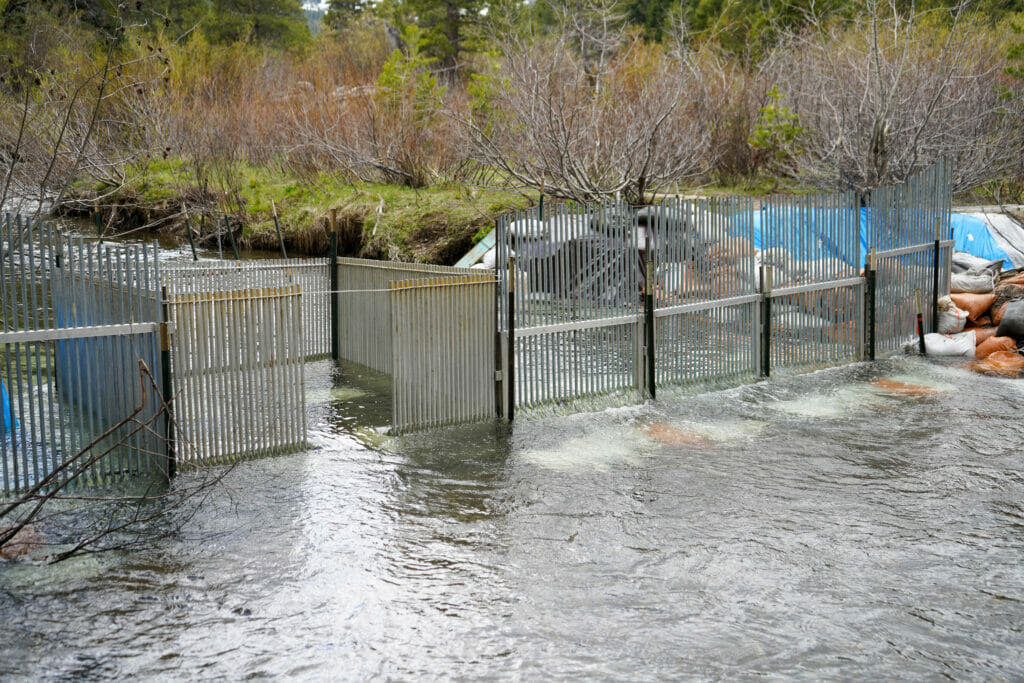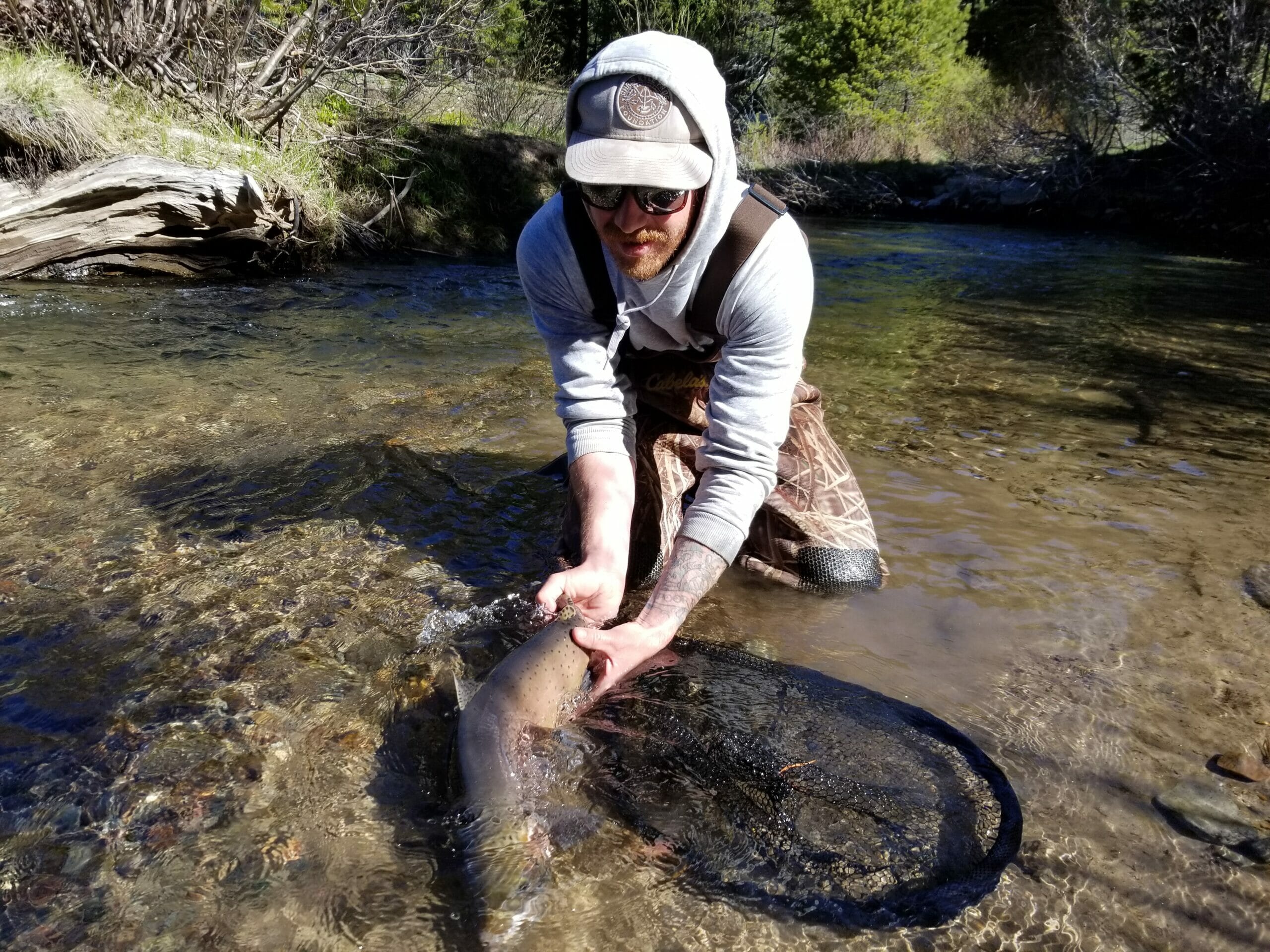By Jason Barnes
As one of only two lakes in the world to support a relict self-sustaining and naturally reproducing population of Lahontan cutthroat trout, a threatened species under the Endangered Species Act, Independence Lake is irreplaceable.
We are no stranger to adverse conditions at the high elevation lake near Truckee, Calif., but even the melting 200 percent snowpack during the 2018-19 winter tested our engineering skills during annual construction of a weir to keep Lahontan cutthroat trout from ascending Independence Creek from the lake. It took 400 sandbags, 200-feet of cable, 75 T-posts and three weeks of grueling work in nearly freezing weather, but we finally got the temporary barrier constructed.

With such rare fish you might wonder why we went to such an extreme to STOP them from entering the stream to spawn and, you would be right to do so, but first you need to know the situation at Independence Lake is a dire one.
The Nature Conservancy has acquired the land around the lake to preserve a one-of-a-kind functioning ecosystem that includes the largest cutthroat trout species on the planet. Bears, otters, eagles and osprey feed regularly on the spawning cutthroat which often exceed 30-inches in length.
Years ago, the United States Geological Survey, under the direction of Gary Scoppettone, developed a population viability analysis that showed Eastern brook trout as the single largest threat to the dwindling Lahontan population in the lake. From 1997 to 2015, USGS worked furiously to figure out ways to count cutthroats in the lake, tally the spawning run, and eliminate the brook trout population from Independence Creek. Innovative methods for removal of Eastern brook trout from the creek were successful, bringing the numbers from the thousands down to around 400 when the USGS office was forced to close the project due to a federal government shutdown. The USGS office was eventually closed, putting years of work to save the population at risk with no clear plan moving forward.
That’s when Trout Unlimited stepped in. State and federal agencies were unable to dedicate the staff time and energy it took to carry on the USGS legacy, which every year requires a minimum seven weeks of intensive field work. In heavy snow years, like the winter of 2018-2019, the work can stretch on for as long as four months – a luxury rarely afforded to agencies that have multiple priorities across a much larger area. TU had the flexibility to adapt to these changing needs and provide consistent people power to ensure the work of the collective partnership continued.

Each September, California Department of Fish and Wildlife heads to the lake with electrofishing boats to remove adult brook trout and other nonnative fishes from the lake while Trout Unlimited crews, funded by the National Fish and Wildlife Foundation, work on the creek. Since 2015 we have reduced numbers of brook trout in Independence Creek down to the single digits and last year no brook trout were found in the lake. Success, right?
Not exactly. A range-wide genetic analysis of Lahontan cutthroat populations in Nevada, California and Oregon done by Helen Neville, Trout Unlimited’s senior scientist and UC-Davis in 2018 turned up hybrids — a mix Lahontan cutthroat and rainbow trout — in Independence Lake samples.
Just as we thought our work to ensure the cutthroat population in Independence Lake was free from the threat of Eastern brook trout, this development came as terrible news. There was a lot of speculation about how the nonnative rainbow trout got in the lake, but evidence points to dam maintenance. The lake was lowered for maintenance in 2012 and the velocity barrier that once kept downstream fish from moving up into the lake was gone. A few rainbows made it into the lake and spawned with the native cutthroat and now we are left with a new issue to deal with.
This is where blocking the annual spawning run comes in, as an important strategy to help manage and reduce hybridization. Lahontans are tagged and genetic samples taken for each of the fish captured. Fish are analyzed at the University of Nevada to determine if they are hybrids and only the pure cutthroat are physically passed above the weir to spawn. Our hope is that we can tag as many as possible to ensure we are passing as many of them as we can above the weir to spawn.
Last year Trout Unlimited and California Department of Fish and Wildlife crews caught 170 Lahontan cutthroat trout and 14 of those sampled were found to be hybridized. That means that 156 of those LCT were ‘pure’, so we hope at least some of them will attempt to spawn this year and keep adding to the population.

This year, we faced a new challenge: with the COVID-19 situation, we weren’t even sure we would be able to have a crew up at Independence Lake and worried much of the work we had done previously would be lost if the hybrids were able to spawn. Thankfully, Trout Unlimited, The Nature Conservancy, and the Calfornia Department of Fish and Wildlife worked together and to get a team to the lake.
Brandon Reeder and Monika Larson faithfully isolated for weeks before the season and are now living out their summer at Independence Lake. The Nature Conservancy graciously allowed the two TU crew members to stay in one of their cabins so they can complete the important cutthroat work at Independence Lake.
The weir was installed the Friday before Memorial Day and had the first fish run up the creek the very next day. We are fortunate to have dedicated TU employees and a U.S. Fish and Wildlife employee who came up on his day off to help us get the weir in just in time. We will continue to staff the weir and catch and tag as many fish as possible this year in hopes every year the spawn run will grow stronger.
These may be strange times for all of us, but in some ways it’s business as usual for the TU LCT team – you just never know what you’ll get into in any given year, but one thing remains constant: There’s always work to be done and we’ll be there to do it.
Jason Barnes is the Lahontan Cutthroat Trout Biologist/Coordinator for Trout Unlimited. He is technically based out of Reno, Nevada, but is rarely in town. To say he is dedicated to Lahontan cutthroat trout would be a serious understatement.



